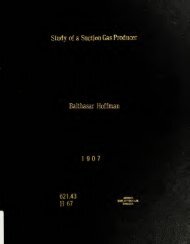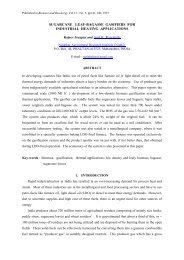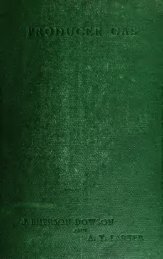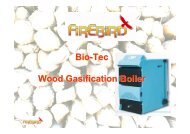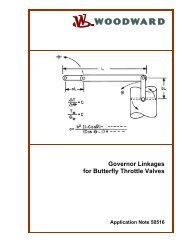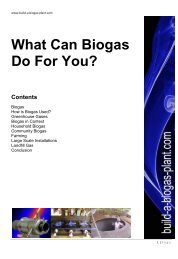Biological delignification of wood and straw for ethanol ... - ghp
Biological delignification of wood and straw for ethanol ... - ghp
Biological delignification of wood and straw for ethanol ... - ghp
Create successful ePaper yourself
Turn your PDF publications into a flip-book with our unique Google optimized e-Paper software.
S<br />
BiolojiicaL<br />
662.6f>9 dellgnlf ica tlon <strong>of</strong><br />
.V7biw <strong>wood</strong> <strong>and</strong> <strong>straw</strong> <strong>for</strong><br />
1989 ethanoL production<br />
via solid state<br />
cul ture<br />
T<br />
I.-<br />
RENEWABLE ENERGY<br />
REPORT LIBRARY<br />
STATE DOCUMENTS COLLECTION<br />
,<br />
,,<br />
MONTANA STATE LIBRARY<br />
1515 E. 6th AVE.<br />
HELENA, MONTANA 59620<br />
BIOLOGICAL DELIGNIFICATION OF WOOD<br />
AND STRAW FOR ETHANOL PR0DUCTI0r4<br />
h via SOLID STATE CULTURE<br />
NOVEMBER 1989<br />
PLEASE RETURN<br />
!*•<br />
Prepared <strong>for</strong><br />
MONTANA DEPARTMENT <strong>of</strong> NA TURAL RESOURCES <strong>and</strong> CONSERVA TION
AUG 2 2 1990<br />
MAY 1 ^ 1991<br />
MONTANA STATE LIBRARY<br />
S 6«2 M9 N7ba" 1 9»9 c 1<br />
3 0864 00066314 9<br />
JUL 1 7 1991<br />
S<br />
662. 66;:^<br />
1989<br />
vl* solid state<br />
culture
FINAL REPORT<br />
DNRC GRANT AGREEMENT NO.<br />
RAE-86-1066<br />
<strong>Biological</strong> Deliqnif ication <strong>of</strong> Wood <strong>and</strong> Straw<br />
<strong>for</strong> Ethanol Production<br />
via Solid State Culture<br />
Submitted<br />
to:<br />
Montana Department <strong>of</strong> Natural Resources <strong>and</strong> Conservation<br />
1520 East 6th Avenue, Third Floor<br />
Helena, Montana 59620<br />
Prepared by:<br />
Clif<strong>for</strong>d Bradley<br />
Pauline Wood<br />
Robert Kearns<br />
Bill Black<br />
<strong>of</strong><br />
Mycotech Bioproducts , Inc .<br />
P.O. Box 4113, 630 Utah Ave<br />
Butte, MT 59702<br />
Phone: (406)782-2386<br />
November 15, 19 89
NOTICE<br />
This project was undertaken in part with government support<br />
under contract no. DE-FG79-82BP35776 awarded by the Bonneville<br />
Power Administration <strong>and</strong> a grant awarded by the Montana<br />
Department <strong>of</strong> Natural Resources <strong>and</strong> Conservation. Such support<br />
does not constitute an endorsement by EPA or DNRC <strong>of</strong> the views<br />
expressed in this work, <strong>and</strong> the user agrees to hold EPA <strong>and</strong> DNRC<br />
harmless against any direct or consequential damages claimed by<br />
the user or their parties arising from or related to use or<br />
interpretations <strong>of</strong> this report.<br />
RAE-8«-1066; BT601 11
TABLE OF CONTENTS<br />
Introduction 1<br />
Research Methodology 5<br />
Laboratory <strong>and</strong> Pilot Plant Equipment 6<br />
Organisms 9<br />
Analytical <strong>and</strong> Process Analysis Procedures 9<br />
Direct culture pretreatment methods 11<br />
Ligninase pretreatment methods 12<br />
Results <strong>and</strong> Discussion 17<br />
Description <strong>of</strong> Process Options 17<br />
Direct Culture Pretreatment 18<br />
Ligninase Pretreatment 20<br />
Whole-cell ligninase 21<br />
Cell-free ligninase 22<br />
Overall Process Description <strong>of</strong> Lignocellulose<br />
to Ethanol 26<br />
Preliminary Economics 27<br />
Results <strong>and</strong> Conclusions 28<br />
Appendices 31<br />
1) Work Schedule 31<br />
2) Budget 31<br />
3) Technology Transfer/Commercialization<br />
Activities 33<br />
4) References 33<br />
RAE-86-1066: BT601 HI
INTRODUCTION<br />
Lignocellulosic materials are a promising feedstock <strong>for</strong><br />
alcohol fuel production. Lignocellulosic materials are abundant<br />
<strong>and</strong> renewable. As an alternative energy source, low-value or<br />
waste lignocellulosic material can be used without affecting<br />
supplies <strong>of</strong> food <strong>and</strong> fiber.<br />
Millions <strong>of</strong> tons <strong>of</strong> low-value or waste lignocellulosic<br />
material are available in Montana as byproducts <strong>of</strong> the<br />
agriculture <strong>and</strong> <strong>for</strong>est products industries. Much <strong>of</strong> this<br />
material is discarded, which creates solid waste disposal<br />
problems. With efficient low-cost conversion technology, wastes<br />
which are now an economic liability can be turned into an asset<br />
as<br />
an energy source.<br />
Lignin, a complex polymer <strong>of</strong> phenylpropanoid molecules in<br />
nonlinear r<strong>and</strong>om linkages, is the major structural component <strong>of</strong><br />
plants. Cellulose is encased in a lignin matrix which must be<br />
degraded be<strong>for</strong>e the cellulose can be enzymatically hydrolyzed to<br />
fermentable<br />
sugars<br />
Most research in lignocellulose conversion has concentrated<br />
on mechanical <strong>and</strong> chemical pretreatments to remove lignin <strong>and</strong> has<br />
emphasized enzymatic hydrolysis <strong>of</strong> cellulose fractions.<br />
Pretreatments <strong>of</strong>ten involve heat <strong>and</strong> are capital <strong>and</strong> energy<br />
intensive. Chemical solvent extractions also have a potentially<br />
adverse environmental<br />
impact.<br />
RAE-86-1066:<br />
BT601
A report by the Solar Energy Research Institute contains a<br />
detailed description <strong>and</strong> economic analysis <strong>of</strong> lignocellulose<br />
mechanical/chemical pretreatment followed by enzymatic hydrolysis<br />
<strong>and</strong> fermentation <strong>of</strong> the cellulose. Two <strong>of</strong> the most limiting<br />
economic factors in alcohol production from lignocellose are<br />
pretreatment <strong>and</strong> cellulase costs.<br />
In research supported by the U.S. Department <strong>of</strong> Energy under<br />
the Small Business Innovation Research Program (SBIR), Mycotech<br />
adapted solid state culture (SSC) technology to production <strong>of</strong> a<br />
low-cost cellulase <strong>for</strong> use in biomass conversion.^ This work<br />
successfully developed a cellulase preparation that is about onefifth<br />
the cost <strong>of</strong> liquid culture preparations <strong>for</strong> equivalent<br />
activity levels. The potential to use Mycotech 's SSC technology<br />
to produce lignin degrading enzymes led to the concept <strong>of</strong> a<br />
completely biological process <strong>for</strong> producing alcohol from<br />
lignocellulosic<br />
feedstocks.<br />
White rot fungi are a class <strong>of</strong> <strong>wood</strong> decaying organisms that<br />
enzymatically degrade lignin.^ One organism, Phanerochaete<br />
chrysosporium has been the subject <strong>of</strong> considerable research.''<br />
The lignin degrading enzyme system produced by this organism in<br />
nitrogen limited, stationary liquid culture systems has been<br />
purified. White rot fungi have high oxygen requirements'^'''® <strong>and</strong><br />
unusual responses to nitrogen <strong>and</strong> carbon concentration in liquid<br />
growth media. '^° As a result it has been difficult to develop<br />
efficient liquid culture systems that can be scaled up<br />
RAE-86-1066;<br />
BT601
economically <strong>for</strong> ligninase' production or lignocellulose<br />
pretreatment. White rot fungi produce ligninases when grown on<br />
solid substrates; however, commercial application is seen as<br />
infeasible because <strong>of</strong> long culture times <strong>and</strong> because solid<br />
culture technology is generally regarded by the U.S. fermentation<br />
industry as unconventional <strong>and</strong> difficult to apply on a large<br />
scale<br />
With support from DNRC^^ <strong>and</strong> USDOE,^ Mycotech developed<br />
innovative solid culture technology that is:<br />
low in capital <strong>and</strong> operating cost<br />
suitable <strong>for</strong> large scale operations<br />
widely adaptable to fungi that per<strong>for</strong>m poorly in liquid<br />
culture<br />
This technology has been developed on a small scale <strong>for</strong> a<br />
pilot project to produce amylase <strong>and</strong> cellulase enzyme<br />
preparations. It is based on innovations in substrate<br />
characteristics, culture reactor design, <strong>and</strong> monitoring <strong>and</strong><br />
control systems. Computerized monitoring <strong>and</strong> control systems<br />
were developed with support<br />
from DNRC."<br />
Mycotech 's proposal to develop a process <strong>for</strong> biological<br />
delignif ication arose out <strong>of</strong> the company's SSC capability, the<br />
development <strong>of</strong> a low-cost cellulase, <strong>and</strong> the availability <strong>of</strong><br />
sophisticated SSC monitoring <strong>and</strong> control systems. The proposal<br />
was submitted in March 1986, <strong>and</strong> the grant was awarded June 1986.<br />
• The term ligninase will be used throughout this report to refer to the multiple enzymes involved in<br />
degradation or modification <strong>of</strong> lignin.<br />
RAE-86-1066:<br />
BT601
During this project, two other contracts were obtained <strong>for</strong><br />
work with white rot fungi. The first was a U.S. Department <strong>of</strong><br />
Energy phase I SBIR project to evaluate solid culture <strong>for</strong><br />
production <strong>of</strong> cell-free ligninase enzyme preparations. The<br />
second was a contract with a private European company to produce<br />
ligninase preparations from a variety <strong>of</strong> white rot fungi <strong>for</strong><br />
application testing in improving paper pulp. These projects<br />
provided a much wider range <strong>of</strong> enzyme samples <strong>for</strong> analysis in the<br />
DNRC project than would otherwise have been available.<br />
RAE-86-1066,<br />
8T601
RESEARCH METHODOI/XSY<br />
The overall objective <strong>of</strong> the project was to find a process<br />
<strong>for</strong> biological delignif ication that could be integrated with SSC<br />
technology to produce <strong>and</strong> use a low-cost cellulase on Montanaspecific<br />
lignocellulosic materials to produce <strong>ethanol</strong>. Meeting<br />
this objective would result in a low-cost biological technology<br />
which integrates lignin removal, cellulose hydrolysis, <strong>and</strong><br />
fermentation to convert lignocellulose to alcohol fuel. Work<br />
emphasized the use <strong>of</strong> low-value or waste material from <strong>for</strong>estry<br />
<strong>and</strong><br />
agriculture products.<br />
A literature search revealed that none <strong>of</strong> the existing<br />
processes are commercially promising. The literature on liquid<br />
culture ligninase sometimes conflicts with solid culture results,<br />
particularly over nutrient <strong>and</strong> oxygen responses <strong>and</strong> whether<br />
liquid culture ligninases will completely depolymerize<br />
^ 12,13,14,15<br />
1<br />
iignin ^^i ,•<br />
The literature does suggest two principal alternative routes<br />
to developing a biological delignif ication process. The first<br />
alternative is a delignif ication pretreatment process by direct<br />
culture <strong>of</strong> the fungus on the fermentation feedstock. This<br />
approach is suggested by studies which evaluated cultures <strong>of</strong><br />
white rot fungi on plant residue^* <strong>and</strong> on <strong>wood</strong> <strong>and</strong> kraft <strong>wood</strong><br />
pulp as a bleaching step.^^'^® This alternative is referred to<br />
throughout this report as direct culture pretreatment . The<br />
second alternative would use SSC <strong>for</strong> culture <strong>of</strong> white rot fungi<br />
RAE-86-1066: BT601 5
s<br />
to produce a commercial ligninase preparation. The ligninase<br />
preparation would be used to pretreat lignocellulose prior to (or<br />
simultaneously with) enzymatic cellulose hydrolysis. The<br />
feasibility <strong>of</strong> this approach is suggested by RTI '<br />
work with<br />
cellulase production <strong>and</strong> the studies^**'^ describing production <strong>of</strong><br />
extracellular ligninase by white rot fungi. This procedure is<br />
referred to throughout this report as ligninase pretreatment . A<br />
diagram <strong>of</strong> alternative process <strong>and</strong> options evaluated in the<br />
project is shown in Figure 2 in the next section.<br />
Much <strong>of</strong> the work was devoted to developing methodologies <strong>and</strong><br />
analytical procedures as a basis <strong>for</strong> evaluating the process<br />
options. This section will describe laboratory <strong>and</strong> pilot plant<br />
equipment, laboratory processes used in evaluating direct culture<br />
<strong>and</strong> ligninase pretreatment, <strong>and</strong> analytical procedures.<br />
Laboratory <strong>and</strong> Pilot Plant Equipment<br />
Three types <strong>of</strong> experimental solid culture systems were used<br />
in the project. These were: the 10-culture test st<strong>and</strong> with<br />
computer monitoring <strong>and</strong> control developed as part <strong>of</strong> previous<br />
DNRC sponsored work' (Contract RAE 85 1055); pilot reactors<br />
constructed as part <strong>of</strong> the DOE, SBIR phase II cellulase project^;<br />
<strong>and</strong> a new laboratory test st<strong>and</strong> built <strong>for</strong> this project. The new<br />
test st<strong>and</strong> was developed without sophisticated monitoring <strong>and</strong><br />
control systems as a low-cost way to increase capacity. This was<br />
necessary because <strong>of</strong> long culture times, the need to screen<br />
RAE-86-1066;<br />
BT601
substrates, <strong>and</strong> the need to evaluate a wide range <strong>of</strong> variables in<br />
direct culture pretreatment processes. The test rack was built<br />
to hold 15, 250 cc polycarbonate culture tubes, each with<br />
individual manual control <strong>for</strong> humidified air flow. Two gases,<br />
typically air <strong>and</strong> oxygen, could be blended. Temperature was<br />
controlled by an air heater in the enclosed test st<strong>and</strong>. This was<br />
a modification <strong>of</strong> the proposed design to allow more flexibility<br />
in h<strong>and</strong>ling cultures .<br />
st<strong>and</strong>.<br />
Figure<br />
1 is a photograph <strong>of</strong> the test<br />
Figure 1. Laboratory SSC test st<strong>and</strong>,<br />
RAE-86-1066:<br />
BT601
Pilot reactors were 6-inch X 30-inch glass columns holding<br />
about 2 kg <strong>of</strong> dry weight substrate. Reactors were modified by<br />
changes in air systems. In some experiments, reactors were<br />
operated horizontally with 500 grams <strong>of</strong> substrate in a 3-inch<br />
deep bed on a tray. In later experiments, columns stood<br />
vertically <strong>and</strong> were filled to about 28 inches deep. Reactors<br />
were equipped with compressor or fan driven air systems <strong>and</strong><br />
humidifiers. Air flow <strong>and</strong> pressure could be regulated either at<br />
the inlet or outlet <strong>of</strong> the reactor. Monitoring included air flow<br />
rate <strong>and</strong> pressure, temperature, humidity level, <strong>and</strong> oxygen<br />
concentration in exhaust gas.<br />
An air shaker with a capacity <strong>of</strong> 25, 125 ml flasks or 16,<br />
250 ml flasks was also purchased <strong>for</strong> the project to increase<br />
capacity <strong>for</strong> hydrolysis <strong>and</strong> fermentation experiments.<br />
A variety <strong>of</strong> Mycotech's general laboratory support equipment<br />
was used in the project. Key equipment included:<br />
- Blenders<br />
Centrifuge <strong>and</strong> filter systems used in enzyme extraction<br />
Shimadzu 260 recording spectrophotometer used in enzyme<br />
<strong>and</strong> colormetric reducing sugar assays <strong>and</strong> in evaluating<br />
lignin solubilization in pretreatments<br />
Yellow Springs Instrument Model 23A enzymatic glucose<br />
analyzer used in hydrolysis studies<br />
Varian model 3700 gas chromatograph used <strong>for</strong> <strong>ethanol</strong><br />
determinations<br />
Clean rooms used <strong>for</strong> maintenance <strong>and</strong> transfer <strong>of</strong> white<br />
rot fungus cultures<br />
RAE-86-1066:<br />
8T601
Organisms<br />
Organisms tested in the project were selected from<br />
literature review^' <strong>and</strong> because they were being used in related<br />
contract work. Selection criteria included such factors as known<br />
production <strong>of</strong> different types <strong>of</strong> ligninases <strong>and</strong> reports <strong>of</strong> tests<br />
in solid culture. Five organisms were tested in various process<br />
alternatives: Phanerochaete chrysosporium , ''^ Pleurotus<br />
gstreatus./' Phlebia (Merulius) tremellosus /'' Trametes<br />
versicolor .^°'^^ <strong>and</strong> Bierk<strong>and</strong>era adusta .*^^ Cultures were obtained<br />
from public culture collections <strong>and</strong> private companies. Cultures<br />
were maintained on agar slants with periodic transfer to fresh<br />
media. Inoculum cultures were fresh agar slants or liquid<br />
cultures in either carbon nitrogen limited salts media or<br />
glucose, peptone, yeast extract media. Bierk<strong>and</strong>era inoculum<br />
cultures were grown with agitation, while other organisms were<br />
generally grown in stationary culture.<br />
Analytical <strong>and</strong> Process Analysis Procedures<br />
Many methods have been used to directly measure lignin<br />
biodegradation: release <strong>of</strong> radiolabeled carbon dioxide from ^'c<br />
lignin, high per<strong>for</strong>mance chromatography <strong>of</strong> soluble lignin<br />
degradation products, UV absorption scans <strong>of</strong> soluble lignin<br />
degradation products, <strong>and</strong> determination <strong>of</strong> substrate lignin<br />
content using digestion methods .^''^°<br />
The common disadvantage <strong>of</strong><br />
all these methods is difficulty in correlating values <strong>of</strong> lignin<br />
degradation with the bioconversion efficiency <strong>of</strong> pretreated<br />
RAE-86-1066; 8T601 9
lignocellulose feedstocks. As a result, the principal method to<br />
evaluate delignif ication in the project was to measure enzymatic<br />
cellulose hydrolysis <strong>of</strong> pretreated lignocellulose. This is an<br />
indirect measure <strong>of</strong> delignif ication but does provide a direct<br />
measure <strong>of</strong> the end product <strong>of</strong> an enzymatic delignif ication <strong>and</strong><br />
bioconversion process - namely glucose or <strong>ethanol</strong>. With<br />
hydrolysis conditions held constant, variation in the rate <strong>and</strong><br />
extent <strong>of</strong> cellulose hydrolysis is a measure <strong>of</strong> delignif ication<br />
efficiency.<br />
Hydrolysis was assayed by glucose or total reducing sugar<br />
assay. In most cases, glucose assay <strong>of</strong> hydrolysis was used to<br />
evaluate delignif ication processes. However, in some cases yeast<br />
was added to the system <strong>and</strong> results determined as <strong>ethanol</strong>. A<br />
commercial strain <strong>of</strong> Saccharomyces cerevisciae (Gist Brocades<br />
Fermipan) ,<br />
previously used in cellulose hydrolysis <strong>and</strong><br />
fermentation, was used in these experiments.<br />
In general, cellulose hydrolysis was carried out using<br />
either Mycotech's solid culture cellulase or a commercial<br />
cellulase, Genencor 150L, at a dose <strong>of</strong> 1 percent w/w (0.1 g<br />
cellulase per 1 g <strong>of</strong> dry weight lignocellulose). Hydrolysis was<br />
supplemented with a cellobiase preparation (Novo 188) to ensure<br />
that soluble cellodexdrins were quantitatively converted to<br />
glucose. When hydrolysis was carried out as a distinct process<br />
step, conditions were pH 4.8 in 0.4 M acetate buffer at 45° C <strong>for</strong><br />
24 hours. Conditions were varied when hydrolysis was carried out<br />
simultaneously with ligninase treatment <strong>and</strong>/or fermentation.<br />
RAE-S6-1066; BT601 10
Some <strong>of</strong> the analytical methods employed were specific to one<br />
<strong>of</strong> the two processes - direct culture pretreatment <strong>and</strong> ligninase<br />
pretreatment - evaluated in the project.<br />
Direct<br />
culture pretreatment methods<br />
In the direct culture process, white rot fungi were grown on a<br />
lignocellulose feedstock. After a suitable culture period the<br />
material was washed, suspended in buffer, <strong>and</strong> tested <strong>for</strong><br />
cellulose hydrolysis. In some cases, the initial wash was made<br />
quantitatively <strong>and</strong> delignif ication was evaluated by UV scan (320-<br />
190nin) to indicate the level <strong>of</strong> soluble, UV absorbing, lignin<br />
degradation products.<br />
Variables affecting the direct culture process include<br />
organism, inoculum, substrate treatment, culture nutrients, time,<br />
temperature, <strong>and</strong> aeration/Oj enrichment. Lignocellulose<br />
feedstocks tested were barley <strong>straw</strong>, pine <strong>and</strong> fir sawdust, <strong>wood</strong><br />
chips (pine), brown paper bag, <strong>and</strong> two types <strong>of</strong> <strong>wood</strong> pulp (kraft<br />
process hard<strong>wood</strong> <strong>and</strong> s<strong>of</strong>t<strong>wood</strong> pulp from the International Paper<br />
Company) . Organisms tested were Phanerochaete , Phlebia ,<br />
Pleurotus <strong>and</strong> Trametes (these experiments were conducted prior to<br />
receipt <strong>of</strong> Bjerk<strong>and</strong>era ) . In general, a liquid culture started<br />
from a slant was used as an inoculum, although spores from slant<br />
cultures were also employed. Lignocellulose materials were<br />
wetted to 60 - 70 percent moisture content with a nutrient<br />
solution, autoclaved, inoculated, <strong>and</strong> transferred to 250 cc<br />
columns. Aeration was generally at 25 cc per minute with air or<br />
with air supplemented to about 60 percent oxygen. Culture<br />
RAE-86-1066; ST601 11
temperature was 30° C <strong>for</strong> all organisms except Phanerochaete<br />
which was grown at 37° C. Nutrient solutions were varied. A<br />
basic salts solution using low levels <strong>of</strong> inorganic nitrogen was<br />
used <strong>for</strong> nitrogen limited conditions. The nutrient solution was<br />
supplemented with varying levels <strong>of</strong> peptone, yeast extract, <strong>and</strong><br />
glucose <strong>for</strong> high nitrogen/carbon conditions. Veratryl alcohol at<br />
0.7 g/1 in nutrient solution served as an inducer in some<br />
experiments<br />
Ligninase pretreatment methods<br />
In ligninase pretreatment, white rot fungi were grown under<br />
conditions (determined in related contract work) to produce<br />
ligninase. These enzyme production cultures were used either as<br />
solid, whole-cell preparations or as cell-free liquid extracts in<br />
pretreatment <strong>of</strong> lignocellulose feedstocks. Barley <strong>straw</strong> milled<br />
to pass through a 20-mesh screen (0.850mm) was used in all<br />
ligninase pretreatment experiments. In some cases, <strong>straw</strong> was<br />
water washed <strong>and</strong> dried prior to<br />
use.<br />
For whole-cell preparations, whole wet culture was simply<br />
mixed as is, at varying levels, in buffer suspensions <strong>of</strong> barley<br />
<strong>straw</strong> <strong>and</strong> incubated <strong>for</strong> 12 hours to 7 days. Tests included<br />
whole-cell preparations from Phanerochaete , Trametes, Phlebia .<br />
<strong>and</strong> Bjerk<strong>and</strong>era .<br />
Cell-free enzyme preparations were made by extracting enzyme<br />
production cultures in water or salt solutions followed by<br />
centrifuging <strong>and</strong> filtering through .<br />
8u<br />
polypropylene filters.<br />
Two organisms, Trametes <strong>and</strong> Bjerk<strong>and</strong>era , were used <strong>for</strong> cell-free<br />
RAE-66-1066; BT601 12
ligninase preparations. Two ligninase preparations from liquid<br />
culture <strong>of</strong> Phanerochaete were obtained from another company <strong>and</strong><br />
used<br />
<strong>for</strong> comparison.<br />
Pretreatment reactions with peroxide <strong>and</strong> manganese dependent<br />
ligninase activities were supplemented as appropriate. Reaction<br />
buffers were acetate pH 4.5, tartrate pH 3.5, tartrate pH 4.0,<br />
malanate pH 3.5, malanate pH 4.0, or phosphate pH 5.7. After<br />
treatment, <strong>straw</strong> was either removed, washed, <strong>and</strong> resuspended in<br />
cellulose hydrolysis buffer, or buffer <strong>and</strong> cellulase were added<br />
directly to the reaction flask. Wash liquid was evaluated by UV<br />
scans<br />
Different enzyme assay procedures were used to evaluate<br />
enzyme preparations depending on the organism <strong>and</strong> type <strong>of</strong><br />
ligninase activity. Enzyme assays were based on oxidation <strong>of</strong><br />
lignin model compounds - veratryl alcohol,* phenol red,^' <strong>and</strong> anis<br />
alcohol. ^^ Veratryl alcohol <strong>and</strong> anis alcohol are oxidized to the<br />
aldehyde with a corresponding increase in optical density at<br />
310nm <strong>for</strong> veratryl aldehyde <strong>and</strong> 285nm <strong>for</strong> anis aldehyde. In the<br />
phenol red assay, oxidation was carried out at acidic pH (3.5 -<br />
5.5). When the reaction is stopped by changing pH to alkaline<br />
conditions, the degree <strong>of</strong> oxidation is determined by a change in<br />
absorption <strong>of</strong><br />
600nin.<br />
RAE-86-1066: BT601 13
The choices <strong>of</strong> organism <strong>and</strong> culture conditions were used to<br />
produce four different types <strong>of</strong> ligninase activities from solid<br />
culture:<br />
Peroxidase: Hydrogen peroxide dependent oxidation <strong>of</strong><br />
phenol red or veratryl alcohol.<br />
Mn Peroxidase: Hydrogen peroxide <strong>and</strong> manganese<br />
dependent oxidation <strong>of</strong> phenol red or veratryl alcohol.<br />
Mn dependent Oxidase:<br />
phenol red,<br />
Manganese dependent oxidation <strong>of</strong><br />
Oxidase/Laccase: Oxidation <strong>of</strong> phenol red, veratryl alcohol,<br />
or anis alcohol without hydrogen peroxide or manganese.<br />
Each organism produced one or more <strong>of</strong> the four types <strong>of</strong><br />
ligninase. However, the different types <strong>of</strong> enzyme from Trametes<br />
<strong>and</strong> Bierk<strong>and</strong>era solid culture <strong>and</strong> Phanerochaete liquid culture<br />
showed significant differences in oxidation <strong>of</strong> the different<br />
lignin model compounds. This indicates that the same type <strong>of</strong><br />
enzyme (i.e., peroxidase) from the different organisms <strong>and</strong><br />
culture systems functions differently.<br />
By varying culture conditions, Trametes cultures could be<br />
manipulated to selectively produce each <strong>of</strong> the four types <strong>of</strong><br />
activities. Trametes enzyme would oxidize phenol red but not<br />
veratryl or anis alcohol. Culture extracts were assayed at pH<br />
4.5 in acetate buffer with all combinations <strong>of</strong> the presence or<br />
absence <strong>of</strong> peroxide <strong>and</strong> manganese to distinguish the different<br />
types <strong>of</strong> activity. Bierk<strong>and</strong>era cultures could be manipulated to<br />
selectively produce either a manganese dependent peroxidase or an<br />
oxidase. Both enzymes oxidized anis alcohol <strong>and</strong> veratryl<br />
alcohol<br />
RAE-66-1066; BT601 14
The two Phanerochaete liquid culture preparations were: a<br />
peroxidase (not requiring manganese) that oxidized veratryl<br />
alcohol but only poorly oxidized phenol red <strong>and</strong> anis alcohol, <strong>and</strong><br />
a laccase that oxidized phenol red but no other compounds.<br />
Assays did not distinguish whether the non hydrogen<br />
peroxide, non manganese dependent Trametes activity was an<br />
oxidase or a laccase. The Bierk<strong>and</strong>era enzyme was an oxidase,<br />
requiring molecular oxygen <strong>for</strong> activity <strong>and</strong> generating H2O2 as a<br />
reaction product. ^^ The Phanerochaete liquid culture was<br />
described by the donor as a laccase.<br />
These enzyme preparations provided a wide spectrum <strong>of</strong><br />
ligninase activities. They were tested singly <strong>and</strong> in various<br />
combinations in the pretreatment <strong>of</strong> barley <strong>straw</strong>. Four different<br />
delignif ication process options were tested using cell-free<br />
ligninase preparations as shown in Figure 2 in the next section.<br />
In sequential process steps, reaction conditions <strong>of</strong> pH, buffer,<br />
<strong>and</strong> temperature could be varied <strong>for</strong> ligninase treatment <strong>and</strong> then<br />
changed to optimum conditions <strong>for</strong> cellulase. In simultaneous<br />
treatment steps, compromise conditions were employed. Generally,<br />
Trametes enzyme was used in acetate buffer pH 4.5 - 5.0,<br />
Bierk<strong>and</strong>era enzyme in phosphate buffer pH 5.0 - 5.7, <strong>and</strong><br />
Phanerochaete liquid culture preparations in tartrate pH 3.5 -<br />
4.5. However, a large number <strong>of</strong> variations were tested.<br />
Hydrogen peroxide <strong>and</strong> manganese were<br />
added when using<br />
peroxidases<br />
RAE-86-1066: BT601 15
Controls were run with all experiments. The basic procedure<br />
was to run controls without ligninase through the entire<br />
pretreatment (duplicating incubation times, different buffers,<br />
etc.) <strong>and</strong> through the hydrolysis procedure being tested. This<br />
provided a background hydrolysis level <strong>for</strong> <strong>straw</strong> in each<br />
treatment variation tested.<br />
RAE-86-1066: BT601 16
RESULTS AND DISCUSSION<br />
The two overall process <strong>and</strong> the options within each process<br />
that were tested during the project are described below <strong>and</strong> shown<br />
in Figure 2<br />
Description <strong>of</strong> Process Options<br />
1) Direct Culture Pretreatment<br />
Delignif ication by direct culture <strong>of</strong> white rot fungi on<br />
lignocellulose feedstock. Two process options <strong>for</strong><br />
hydrolysis <strong>and</strong> fermentation <strong>of</strong> pretreated feedstock were<br />
tested.<br />
A. Sequential cellulose hydrolysis <strong>and</strong> fermentation<br />
in two separate process steps<br />
B. Simultaneous cellulose hydrolysis <strong>and</strong> fermentation<br />
in a single process step.<br />
2) Ligninase Pretreatment<br />
Delignif ication by treatment with ligninase enzyme<br />
preparations. Fungus is grown using substrates <strong>and</strong> culture<br />
conditions <strong>for</strong> optimal ligninase production. Six process<br />
options were tested.<br />
Whole-cell Ligninase: Whole culture used as ligninase<br />
preparation.<br />
A. Sequential ligninase pretreatment <strong>and</strong> cellulose<br />
hydrolysis in two separate process steps.<br />
B. Simultaneous ligninase pretreatment <strong>and</strong> cellulose<br />
hydrolysis in one process step.<br />
Cell-free Ligninase: Ligninase production culture extracted<br />
<strong>and</strong> filtered to remove cells <strong>and</strong> culture solids.<br />
C. Sequential ligninase pretreatment, cellulose<br />
hydrolysis, <strong>and</strong> fermentation in three separate<br />
process steps.<br />
D. Sequential ligninase pretreatment, <strong>and</strong><br />
simultaneous cellulose hydrolysis <strong>and</strong> fermentation<br />
in two process steps<br />
RAE-86-1066; BT601 17
^<br />
I i<br />
0)<br />
E<br />
cS<br />
0)<br />
0)<br />
C<br />
0)<br />
E<br />
0)<br />
"S<br />
lU<br />
3<br />
o<br />
o<br />
0)<br />
m<br />
o<br />
CD<br />
c<br />
c<br />
CN<br />
03
E. Simultaneous ligninase pretreatment <strong>and</strong> cellulose<br />
hydrolysis followed by fermentation in two process<br />
steps<br />
F. Simultaneous ligninase pretreatment, cellulose<br />
hydrolysis, <strong>and</strong> fermentation in a single process<br />
step.<br />
Direct Culture Pretreatment<br />
Direct culture pretreatment experiments evaluated four<br />
different fungi grown on seven different representative<br />
lignocellulosic materials. Steam-rolled barley was used as a<br />
control<br />
with known solid culture characteiistics<br />
Best cell growth was obtained using <strong>straw</strong> with 1-5 percent<br />
ground paper bag. Very high cell densities were obtained in 7-<br />
20 day culture times. Wood pulp also supported good growth, <strong>and</strong><br />
in samples returned to International Paper, showed reduction in<br />
lignin content as measured by brightness <strong>and</strong> Kappa number<br />
(residual lignin content). Fir sawdust showed no growth <strong>and</strong> pine<br />
sawdust minimal<br />
growth.<br />
Experiments were repeated using <strong>straw</strong> as the substrate with<br />
variations in culture time, nutrients, oxygen enrichment, <strong>and</strong><br />
organism. In the majority <strong>of</strong> experiments, subsequent hydrolysis<br />
with cellulase showed no significant difference in glucose yield<br />
or extent <strong>of</strong> hydrolysis compared with untreated controls. In<br />
most cases glucose yield was less than in controls. With some<br />
Phanerochaete <strong>and</strong> Pleurotus treated <strong>straw</strong>, there was about a 10<br />
percent increase in glucose yield. In these experiments, the<br />
extent <strong>of</strong> hydrolysis <strong>of</strong> untreated <strong>straw</strong> controls was about 9<br />
percent, <strong>and</strong> the best level achieved with direct culture<br />
RAE-86-1066; BT601 18
pretreatment was about 10 percent. This compares with about 50<br />
percent hydrolysis obtained with <strong>straw</strong> chemically delignified by<br />
autoclaving in 1 percent NaOH, followed by washing <strong>and</strong><br />
neutralization.<br />
In treatments showing increased cellulose hydrolysis the<br />
amount <strong>of</strong> glucose produced was to small to be practical. The<br />
decreased hydrolysis seen in most experiments was probably due to<br />
the use <strong>of</strong> cellulose by the fungus thereby reducing the cellulose<br />
available <strong>for</strong> subsequent enzymatic hydrolysis. Assays <strong>of</strong><br />
Pleurotis <strong>and</strong> Phanerochaete culture showed cellulase activity.<br />
The cellulase concentration was probably sufficient to hydrolyze<br />
readily accessible cellulase in the <strong>straw</strong> with the resulting<br />
glucose used by the fungus<br />
Several experiments were conducted in which glucose or<br />
starch was added to the cultures in an attempt to repress<br />
cellulase production. No repression was found. Enrichment <strong>of</strong><br />
the culture atmosphere up to 100 percent oxygen had no effect on<br />
subsequent hydrolysis results.<br />
Water extracts <strong>of</strong> culture material did show much higher<br />
levels <strong>of</strong> soluble lignin than controls as shown by UV absorption.<br />
Often <strong>straw</strong> would be visibly lighter in color after direct<br />
culture pretreatment. Both <strong>of</strong> these results indicated extensive<br />
delignif ication <strong>of</strong> the <strong>straw</strong>; however, there was never a<br />
significant increase in cellulose hydrolysis.<br />
RAE-86-1066: BT601 19
Ligninase Pretreatment<br />
Pretreatment with a ligninase preparation has a wider range<br />
<strong>of</strong> process options than direct culture as shown in Figure 2. in<br />
this process, the fungus is grown under conditions <strong>for</strong> optimal<br />
production <strong>of</strong> specific ligninase enzymes. The whole culture may<br />
be used as an enzyme preparation, or the ligninase can be<br />
extracted to produce a cell-free liquid enzyme preparation. A<br />
whole-cell preparation might be the best option <strong>for</strong> on-site<br />
enzyme production <strong>and</strong> biomass utilization, while a cell-free<br />
enzyme could be produced <strong>and</strong> marketed from a central location.<br />
Whole-cell preparations could contain enzyme activities bound to<br />
culture substrate that would be lost in extraction. Cell-free<br />
enzyme preparations may not contain inhibitors or undesirable<br />
activities that could be present in whole-cell culture<br />
preparations. With each type <strong>of</strong> enzyme preparation, the<br />
enzymatic ligninase <strong>and</strong> cellulase reactions <strong>and</strong> fermentation<br />
steps were tested both sequentially <strong>and</strong> simultaneously.<br />
Sequential processes have the advantage that each reaction can be<br />
run at optimal conditions. Simultaneous processes have the<br />
advantage <strong>of</strong> simplicity in process design <strong>and</strong> equipment.<br />
Whole-cell enzyme preparations were evaluated in sequential<br />
<strong>and</strong> simultaneous delignif ication <strong>and</strong> cellulase hydrolysis. Cellfree<br />
enzyme preparations were tested in both sequential <strong>and</strong><br />
simultaneous enzyme steps <strong>and</strong> in enzyme steps coupled with<br />
fermentations. Fermentations were run as a third sequential<br />
RAE-86-1066; BT601 20
step, simultaneously with the cellulase hydrolysis step <strong>and</strong><br />
simultaneously with both enzyme reactions.<br />
A number <strong>of</strong> variables were evaluated <strong>for</strong> each step in each<br />
<strong>of</strong> the process options. These included:<br />
- Straw concentration<br />
- Ligninase source organism<br />
- Ligninase type (peroxidase, oxidase, or mixtures)<br />
- Ligninase concentration <strong>and</strong> reaction time<br />
- Buffer system <strong>and</strong> pH<br />
- Control <strong>of</strong> bacterial <strong>and</strong> fungal growth<br />
- Cellulase preparation <strong>and</strong> concentration<br />
- Fermentation conditions<br />
Whole-cell<br />
ligninase<br />
In experiments with whole-cell ligninase preparations, <strong>straw</strong><br />
concentration was a slurry <strong>of</strong> 10 percent <strong>straw</strong> or a moist solid<br />
at 30 percent <strong>straw</strong>. In sequential cellulose hydrolysis, <strong>straw</strong><br />
concentration was 5 percent after all additions <strong>of</strong> buffer <strong>and</strong><br />
enzyme. Trametes preparations were cultures with peroxidase,<br />
manganese-dependent peroxidase, or oxidase activities.<br />
Bjerk<strong>and</strong>era preparations contained manganese dependent peroxidase<br />
or laccase, <strong>and</strong> Phlebia contained peroxidase. Trametes <strong>and</strong><br />
Bjerk<strong>and</strong>era enzymes were tested singly <strong>and</strong> in numerous ^<br />
combinations. Liquid culture Phanerochaete peroxidase <strong>and</strong><br />
laccase preparations were added to whole-cell preparations in<br />
some experiments. Enzyme concentrations <strong>of</strong> 10 - 50 percent <strong>of</strong><br />
the weight <strong>of</strong> <strong>straw</strong> were tested with reactor times <strong>of</strong> 12 hours to<br />
seven days. Acetate <strong>and</strong> tartrate buffers <strong>and</strong> unbuffered systems<br />
were tested. Straw was used either sterilized in buffer or<br />
unsterilized with ammonium bifluoride or antibiotics added in<br />
RAE-86-1066, BT601 21
some cases to suppress bacterial growth. Cellulase was a<br />
commercial preparation<br />
from Genencor.<br />
Results<br />
showed delignif ication with solxd culture Trametes<br />
<strong>and</strong> liquid culture Phanaerochaete preparations as measured by UV<br />
absorption <strong>of</strong> lignin degradation products in wash water from<br />
treated <strong>straw</strong>. Inactivated whole culture ligninase preparations<br />
were used in these experiments to control <strong>for</strong> lignin degradation<br />
products introduced with the crude enzyme preparations. In some<br />
cases, washed treated <strong>straw</strong> was visibly lighter in color. These<br />
indications <strong>of</strong> delignif ication did not correlate with significant<br />
increases in cellulose hydrolysis. Best results were about 10<br />
percent conversion <strong>of</strong> total <strong>straw</strong> weight compared with about 8 -<br />
9 percent in controls. Both the extent <strong>of</strong> conversion <strong>and</strong><br />
relative increase compared with controls were not significant.<br />
Cell-free<br />
ligninase<br />
Cell-free enzyme preparations were<br />
tested extensively using<br />
solid culture extracts with peroxidase <strong>and</strong> oxidase from Trametes<br />
<strong>and</strong> Bierk<strong>and</strong>era <strong>and</strong> the liquid Phanerochaete preparations.<br />
Ligninase preparations were used singly <strong>and</strong> in all possible<br />
combinations in both sequential <strong>and</strong> simultaneous cellulase<br />
hydrolyses<br />
An extensive set <strong>of</strong> tests were conducted to follow stability<br />
<strong>of</strong> ligninase in these reactions. The first experiments evaluated<br />
binding to <strong>straw</strong>. With this baseline, delignif ication reactions<br />
were sampled <strong>and</strong> assayed <strong>for</strong> enzyme activity over time. All<br />
enzyme preparations showed some binding to <strong>straw</strong>. Stability<br />
RAE-86-1066; BT601 22
assays showed that Trametes enzyme could not be recovered from<br />
reaction mixtures after a few hours. This activity, particularly<br />
the oxidase, is either unstable or becomes irreversibly adsorbed<br />
to <strong>straw</strong>. Both Bjerk<strong>and</strong>era <strong>and</strong> Phanerochaete enzymes could be<br />
recovered even after three days <strong>of</strong> reaction, indicating good<br />
stability <strong>and</strong> equilibrium binding conditions.<br />
A variety <strong>of</strong> buffer systems <strong>and</strong> pH pr<strong>of</strong>iles were analyzed.<br />
Optimum conditions <strong>for</strong> each ligninase were used <strong>for</strong> single enzyme<br />
reactions .<br />
In sequential processes with mixed ligninase<br />
preparations <strong>and</strong> in simultaneous cellulase hydrolysis, compromise<br />
conditions were tested. Enzyme assays were run on each enzyme<br />
preparation <strong>and</strong> type <strong>of</strong> ligninase activity to establish buffer<br />
<strong>and</strong> pH range <strong>for</strong> activity. In mixed ligninase systems,<br />
conditions were found in which all components <strong>of</strong> the mixture<br />
showed at least a significant fraction <strong>of</strong> optimal activity.<br />
Cellulase preparations have a pH optimum <strong>of</strong> about 4.8; however,<br />
the activity is retained over a broad pH range. There<strong>for</strong>e,<br />
conditions favorable <strong>for</strong> ligninase activity could be employed in<br />
simultaneous ligninase/cellulase systems.<br />
Reaction times from 12 hours to seven days were run in<br />
different experiments with liquid ligninase concentrations as<br />
high as 50 percent by volume <strong>of</strong> reaction mixtures.<br />
In experiments with long culture times, it was necessary to<br />
control bacterial contamination <strong>and</strong> fungal growth from ligninase<br />
<strong>and</strong> cellulase preparations. A series <strong>of</strong> experiments were<br />
conducted to test the effects <strong>of</strong> several different chemical <strong>and</strong><br />
RAE-W-1066; BT601 23
antibiotic control agents on ligninase <strong>and</strong> cellulase activities.<br />
Combinations were found that did not affect enzyme activity <strong>and</strong><br />
maintained uncontaminated reactions <strong>for</strong> up to a week.<br />
Three different cellulases were employed in these<br />
experiments. The liquid, commercial cellulase is high in<br />
specific (endo- <strong>and</strong> exo- ) cellulase activities, but very low in<br />
"side" activities, particularly hemicellulose degrading xylanase.<br />
Reasoning that hemicellulose degradation may be important in<br />
pretreatment , we tested two cellulase preparations v/ith high<br />
levels <strong>of</strong> xylanase. These were a preparation from Amano <strong>and</strong><br />
Mycotech solid culture cellulase preparations.<br />
Ferinentations were run using buffer <strong>and</strong> bacterial<br />
suppression that did not affect yeast. Fermentation controls<br />
were run using hydroxide delignified <strong>straw</strong> in addition to <strong>straw</strong><br />
without<br />
ligninase treatment.<br />
Results <strong>of</strong> experiments with cell-free ligninases (extracts)<br />
were similar to other process experiments. Straw showed evidence<br />
<strong>of</strong> delignif ication, but economical levels <strong>of</strong> conversion to<br />
glucose or <strong>ethanol</strong> were not obtained. Best results were obtained<br />
in experiments using combinations <strong>of</strong> peroxidase <strong>and</strong> oxidase type<br />
ligninase activities as a pretreatment followed by simultaneous<br />
hydrolysis <strong>and</strong> fermentation <strong>of</strong> the cellulose. (Figure 2, option<br />
D.) In some experiments, alcohol concentrations <strong>of</strong> 0.26 - 0.37<br />
mg/ml were obtained compared with 0.15 - 0.16 mg/ml in controls.<br />
Although twice the alcohol concentration was obtained, overall<br />
conversion <strong>of</strong> <strong>straw</strong> was only about 10 - 12 percent. This<br />
RAE-86-1066; BT601 24
compares poorly with 50 percent overall conversion <strong>of</strong> <strong>straw</strong> that<br />
is<br />
hydroxide pretreated <strong>and</strong> hydrolyzed.<br />
RAE-86-1066: BT601 25
nvT?RAT.T. PRfX:ESS DESCRIPTION OF LIGMOCELLULOSE TO ETHANOL<br />
The overall description <strong>of</strong> alternative processes <strong>for</strong><br />
conversion <strong>of</strong> lignocellulose to <strong>ethanol</strong> was shown in Figure 2 in<br />
the previous section. None <strong>of</strong> the process alternatives we tested<br />
showed economically feasible conversion rates. The best results<br />
were obtained with delignif ication using a<br />
mixed cell-free<br />
ligninase enzyme preparation followed by simultaneous cellulase<br />
hydrolysis <strong>and</strong> fermentation. (Process option D, Figure 2.) A<br />
schematic <strong>of</strong> this type <strong>of</strong> process is shown in Figure 3.<br />
An overall mass <strong>and</strong> energy balance can not be established<br />
from the available data. Overall conversion was too low to<br />
establish ligninase dose response or lignin removal. Alcohol<br />
concentrations in fermentations were only about 0.2 - 0.4 mg/ml<br />
which is too low to economically distill without a concentration<br />
step. Evaluation <strong>of</strong> the mass <strong>and</strong> energy balance <strong>of</strong> a dilute beer<br />
concentration step were beyond the scope <strong>of</strong> this project.<br />
RAE-86-1066; BT601 26
1<br />
o<br />
c<br />
o<br />
= o<br />
O V<br />
(0 cc<br />
o 3<br />
•a<br />
o<br />
a.<br />
»<br />
><br />
><br />
c<br />
o<br />
g<br />
Ip<br />
>, c<br />
U X u.<br />
0) >. V<br />
g<br />
o<br />
"O<br />
o<br />
qI<br />
O<br />
CO<br />
en<br />
5<br />
<<br />
oc;
PRELIMINARY ECONOMICS<br />
Best results with enzymatic delignif ication showed about a<br />
10 percent overall conversion <strong>of</strong> <strong>straw</strong> to <strong>ethanol</strong> on a weight<br />
basis. The alcohol yield <strong>and</strong> value <strong>for</strong> conversion <strong>of</strong> one ton <strong>of</strong><br />
<strong>straw</strong> is shown below.<br />
2000 lbs <strong>straw</strong> X 0.10 conversion = 200 lbs glucose<br />
200 lbs glucose X 0.51 theoretical molar fermentation<br />
efficiency = 102 lbs <strong>ethanol</strong><br />
102 lbs <strong>ethanol</strong> -r 6 . 6 lbs <strong>ethanol</strong> per gallon = 15.4<br />
gallons<br />
15.4 gallons X $1.55/gallon selling price <strong>for</strong> <strong>ethanol</strong> =<br />
$25.41.<br />
In southwest Montana, the cost <strong>for</strong> <strong>straw</strong> collected <strong>and</strong><br />
delivered to a central point is in the range <strong>of</strong> $25 - $30 a ton.<br />
Conversion efficiencies obtained in the project would not cover<br />
feedstock cost <strong>for</strong> alcohol production. Results did not justify<br />
further in-depth economic analysis.<br />
RAE-86-1066: BT601 27
RESULTS AND CONCLUSIONS<br />
The project did not demonstrate economic feasibility <strong>of</strong> a<br />
completely biological conversion <strong>of</strong> lignocellulose to <strong>ethanol</strong>.<br />
Results consistently showed increased cellulose hydrolysis <strong>of</strong><br />
ligninase pretreated <strong>straw</strong> compared with controls; however, the<br />
increase fell far short <strong>of</strong> conversion efficiencies necessary <strong>for</strong><br />
economic <strong>ethanol</strong> production.<br />
Clearly, <strong>straw</strong> was delignified, but the question remains:<br />
why did this not correlate with increased cellulase hydrolysis.<br />
The extent <strong>of</strong> delignif ication may have been insufficient to<br />
expose a significant fraction <strong>of</strong> the cellulose <strong>for</strong> enzymatic<br />
hydrolysis. Alternatively, there may be other factors critical<br />
to delignif ication in which the enzymatic ligninase <strong>and</strong> cellulase<br />
preparations were not effective. These could include secondary<br />
structures such as linkages between cellulose, hemicellulose, <strong>and</strong><br />
lignin, or tertiary structure limiting access <strong>of</strong> the enzyme.<br />
Delignif ication might be increased by the use <strong>of</strong> higher<br />
enzyme concentrations, longer reaction times, or different types<br />
<strong>of</strong> activities. Economics <strong>of</strong> these steps would be questionable as<br />
the project tested a very wide range <strong>of</strong> ligninase sources,<br />
concentrations, <strong>and</strong> long reaction times without achieving good<br />
yields<br />
There may be some promise in testing a pretreatment that<br />
combines enzymatic, chemical, <strong>and</strong> mechanical processes. The cost<br />
<strong>and</strong> efficiency <strong>of</strong> chemical/mechanical delignif ication might be<br />
RAE-86-1066; BT601 28
improved sufficiently by an enzymatic step to justify enzyme<br />
cost. A mild chemical treatment to disrupt secondary structure,<br />
or milling to disrupt tertiary structure, could improve enzymatic<br />
delignif ication enough <strong>for</strong> a conversion process to be economical.<br />
If further research were to be conducted based on this project, a<br />
combination <strong>of</strong> mechanical, chemical, <strong>and</strong> enzymatic pretreatment<br />
is one recommended approach.<br />
One other important factor may have been the choice <strong>of</strong><br />
lignocellulose feedstock. Barley <strong>straw</strong> was the primary feedstock<br />
<strong>for</strong> this project because it is low in cost <strong>and</strong> readily available<br />
in southwest Montana. Other feedstocks, such as, aspen, poplar,<br />
or other agricultural residues, may be more amenable to enzymatic<br />
pretreatment. This is supported by recent work in Canada^^ using<br />
aspen <strong>wood</strong> delignified by direct culture<br />
treatment with Phlebia<br />
tremellosus . After a 12 week culture time, cellulose hydrolysis<br />
<strong>and</strong> fermentation <strong>of</strong> delignified aspen <strong>wood</strong> yielded 0.116 g<br />
<strong>ethanol</strong> per g <strong>of</strong> <strong>wood</strong> - an overall conversion efficiency <strong>of</strong> about<br />
23 percent <strong>of</strong> theoretical. There may also be partially<br />
delignified waste material such as waste paper in which an<br />
enzymatic delignif ication would be a cost effective conversion<br />
step. These types <strong>of</strong> alternatives were too wide ranging to be<br />
effectively addressed in this project.<br />
In conclusion, the project did make a significant, if<br />
negative, contribution to work in this field. Because <strong>of</strong><br />
integration with two other projects related to white rot fungi,<br />
Mycotech was able to test a large number <strong>of</strong> different enzyme<br />
RAE-86-1066; BT601 29
preparations under a very broad range <strong>of</strong> conditions. A<br />
comprehensive evaluation <strong>of</strong> different types <strong>of</strong> ligninases from<br />
five different fungi does provide a good basis <strong>for</strong> further work,<br />
<strong>and</strong> probably indicates that factors other than ligninase need to<br />
be addressed in future work on enzymatic pretreatment<br />
RAE-86-1066; BT601 30
APPENDICES<br />
1) Work Schedule<br />
The time line <strong>of</strong> the original contract was extended<br />
considerably from April 30, 1988 to September 30, 1989. The<br />
principal reason <strong>for</strong> this was that initial experiments with the<br />
direct culture process route were unsuccessful <strong>and</strong> ef<strong>for</strong>ts were<br />
focused on using ligninase preparations. Mycotech received two<br />
other projects that included work to produce <strong>and</strong> evaluate<br />
ligninase enzyme preparations<br />
from different organisms.<br />
Extending the DNRC project provided a unique opportunity to test<br />
enzyme produced <strong>for</strong> these other projects in the DNRC biomass<br />
conversion project. The increased time allowed testing <strong>of</strong> a much<br />
wider range <strong>of</strong> organisms <strong>and</strong> enzyme preparations, <strong>and</strong> to have<br />
more completely characterized these enzyme preparations,<br />
than<br />
would have been possible within the scope <strong>of</strong> the DNRC project<br />
alone.<br />
2) Budget<br />
Budgeted <strong>and</strong> actual expenses by project milestone are shown<br />
below. The major changes in budgeted vs. actual expenses were in<br />
subcontracts <strong>and</strong> associated travel expenses. Results did not<br />
justify subcontractor tests <strong>of</strong> ligninase preparations. As a<br />
result, the subcontract <strong>and</strong> the supporting travel budget were<br />
transferred to salaries <strong>and</strong> indirect costs <strong>for</strong> additional<br />
experimental work on alternative process options <strong>and</strong> enzyme<br />
preparations<br />
RAE-86-1066; BT601 31
Budget<br />
Summary
3) Technoloqry Transfer/Commercialization Activities<br />
The project did not demonstrate an economically feasible<br />
process <strong>for</strong> enzymatic delignif ication <strong>of</strong> Montana sources <strong>of</strong><br />
lignocellulose. As a result, Mycotech has not initiated any<br />
commercialization activities from this project.<br />
The original work plan included provisions <strong>for</strong> tests to be<br />
subcontracted to SERI (or TVA) using Mycotech ligninase<br />
preparations. Because results did not show significant<br />
pretreatment , the outside tests were dropped in order to conduct<br />
additional tests <strong>of</strong> alternative process options in house.<br />
Because results did not show significant conversion efficiencies,<br />
<strong>and</strong> SERI was not involved in tests, the report was not sent <strong>for</strong><br />
outside<br />
review.<br />
4 )<br />
References<br />
1. Isaacs, S. H. (1984). Ethanol production by Enzyrnatic<br />
Hydrolysis; Parametri c Analysis <strong>of</strong> a Base Case Process. Solar<br />
Energy Research Institute, Golden, Colorado, U.S. DOE Contract<br />
#EG-77-C-01-4042.<br />
2. Bradley, C, Black, W. , Kearns , R., Wood, P. (1987). Solid<br />
State Cultures <strong>of</strong> Trichoderma reesei <strong>for</strong> Cellulase Production.<br />
SBIR Phase II Final Report, U.S. DOE Contract #DE-AC03-<br />
84ER80188. Renewable Technologies, Inc.<br />
3. Hatakka, A., Tervika-wilo, A. (1986). Ligninases <strong>of</strong> white rot<br />
fungi in Proceedings Soviet Finnish Seminar on Microbial<br />
Degradation <strong>of</strong> Lignocellulose Materials. USSR Academy <strong>of</strong><br />
Sciences, Puschino, pp. 65-73.<br />
4. Tien, M. (1987). Properties <strong>of</strong> ligninase from Phanerochaete<br />
chrysosporium <strong>and</strong> their possible applications. CRC Critical<br />
Reviews in Microbiolocry ; 15 (2), 141-168.<br />
I<br />
5. Tien, M., Kirk, T. K. (1984). Lignin-degrading enzyme from<br />
Phanerochaete chrysosporium ; Purification, characterization<br />
<strong>and</strong> catalytic properties <strong>of</strong> a unique hydrogen peroxide<br />
RAE-86-1066; BT601 33
equiring oxygenase. Proc . National<br />
2284.<br />
Academy <strong>of</strong> Science 8 ; 2280-<br />
e.Leisola, M., Ulmer, D., Fiechter, A. (1983). Problem <strong>of</strong> oxygen<br />
transfer during degradation <strong>of</strong> lignin by Phanerochaete<br />
chrysosporium. Eur J Appl Microbiol Biotechnol 17:113-116.<br />
7. Bar-Lev, S., Kirk, T. (1981). Effects <strong>of</strong> molecular oxygen on<br />
lignin degradation by Phanerochaete chrysosporium . Biochem &<br />
Biophys Res Comm 99 ( 2 ): 373-378 .<br />
8. Reid, I., Seifert, K. (1982). Effects <strong>of</strong> an atmosphere <strong>of</strong><br />
oxygen on growth, respiration <strong>and</strong> lignin degradation by white<br />
rot fungi. Canadian J Botany 60:252-260.<br />
9. Jeffries, T., Suki, C, Kirk, T. (1981). Nutritional<br />
regulation <strong>of</strong> lignin degradation by Phanerochaete<br />
chrysosporium . Appl <strong>and</strong> Environ Micro 42 ( 2 ): 290-296 .<br />
lO.Leatham, G., Kirk, T. (1983). Regulation <strong>of</strong> ligninolytic<br />
activity by nutrient nitrogen in white rot basidiomycetes<br />
FEMS Microbiol Lett 16:65-67.<br />
11. Bradley, C, Black, W., Runnion, K. (1987). Commercial<br />
Development: Ambient Temperature Starch Hydrolysis. Final<br />
report to Montana Dept <strong>of</strong> Natural Resources <strong>and</strong> Conservation.<br />
Contract #5 RAE 82-1007 <strong>and</strong> RAE 84-1044. Renewable<br />
Technologies (Mycotech) Inc.<br />
12. Reid, I. (1983). Effects <strong>of</strong> nitrogen supplements on<br />
degradation <strong>of</strong> aspen <strong>wood</strong> lignin <strong>and</strong> carbohydrate components<br />
by Phanerochaete chrysosporium . Appl <strong>and</strong> Environ Micro<br />
45(3) :830-837.<br />
13. Buswell, J. et al . (1984). Lignolytic enzyme production by<br />
Phanerochaete chrysosporium under conditions <strong>of</strong> nitrogen<br />
sufficiency. FEMS Microbiol. Letters 25:295-299.<br />
14. Mycotech Inc. (1989). Unpublished results.<br />
15. Leatham, G. (1989). Personal communication. USDA Forest<br />
Products Laboratory, Madison, WI<br />
16. Zadrazil, F., Brunnert, H. (1982). Solid-state fermentation<br />
<strong>of</strong> lignocellulose containing plant residues with Sporotrichum<br />
pulverulentum Nov. <strong>and</strong> Dichomitus squalens (Karst) Reid. Eur<br />
J. Appl Microbiol Biotechnol 16:45-51.<br />
RAE-86-1066; BT601 34
IT.Reid, I., Deschamps, A. (1986). <strong>Biological</strong> delj.gnif ication<br />
<strong>of</strong> aspen <strong>wood</strong> by solid state fermentation with the selective<br />
lignin degrading fungus Phlebia tremellosus . Biotechnology<br />
in the Pulp <strong>and</strong> Paper Industry. The Third Internati o nal<br />
Conference . Swedish Forest Products Laboratory, 49-51.<br />
18. Kirk, T., Yung, H. (1979). Partial delignif ication <strong>of</strong><br />
unbleached kraft pulp with lignolytic fungi. Biotech Letters<br />
1(9) :347-352.<br />
19. Waldner, R., Leisola, M., Fiechter, A. (1988). Comparison <strong>of</strong><br />
lignolytic activities <strong>of</strong> selected white rot fungi. Appl<br />
Microbiol <strong>and</strong> Biotechnol 29:400-407.<br />
20. Forrester, I. et al . (1989). Manganese, Mn dependent<br />
peroxidases <strong>and</strong> the biodegradation <strong>of</strong> lignin. Biochem<br />
Biophys Res Comm. In press.<br />
21. Jonsson, L. et al . (1987). Purification <strong>of</strong> ligninase<br />
isozymes from the white rot fungus Trametes versicolor . Acta<br />
Chemica Sc<strong>and</strong>inavica 41:766-769.<br />
22.Muheim, A. et al. (1989). An extracellular aryl-alcohol<br />
oxidase from the white rot fungus Bierk<strong>and</strong>era adusta . Enzyme<br />
<strong>and</strong> Microbial Technology. In press.<br />
23. Janshekar, H., Haltmeier, T., Brown, C. (1982). Fungal<br />
degradation <strong>of</strong> pine <strong>and</strong> <strong>straw</strong> alkali lignins. Eur J Appl<br />
Microbiol <strong>and</strong> Biotechnol 14:174-181.<br />
24. Brown, B. (1967). Determination <strong>of</strong> Lignin in Methods <strong>of</strong> Wood<br />
Chemistry Volume II pp. 785-823. John Wiley & Sons.<br />
25 Mes-Hartree, M. et al. (1987). Suitability <strong>of</strong> aspen <strong>wood</strong><br />
biologically delignified with Phlebia tremellosus <strong>for</strong><br />
fermentation to <strong>ethanol</strong> or butanediol. Appl Microbiol<br />
Biotechnol 26:120-125.<br />
RAE-86-1066; BT601 35



